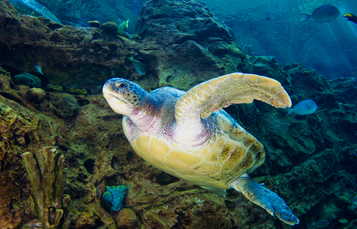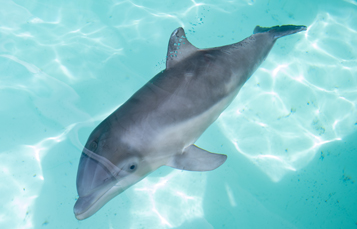Saving the Florida Reef Tract
April 22, 2022Coral reefs are incredibly large, complex underwater ecosystems. Despite occurring in about 1% of the ocean, coral reefs are home to over 25% of all ocean life. They are formed over the course of millennia from coral polyps, and house thousands of unique and diverse species. Just off the eastern coast of Florida lies the Florida Reef Tract, the largest bank reef in the continental United States, which extends 360 miles from Florida’s Martin County to the Dry Tortugas. Unfortunately, the Florida Reef Tract today faces a major crisis — the spread of stony coral tissue loss disease (SCTLD).
SCTLD is a highly infectious and lethal disease that has spread throughout reefs across the Caribbean Sea. Since it was first discovered off the coast of Florida in 2014, this disease has rapidly spread to all sections of the Florida Reef Tract, threatening the existence of not only the coral reefs themselves but of the countless marine animals that inhabit them. This threat requires a massive and coordinated response from both public and private entities. Fortunately, groups such as SeaWorld, the Association of Zoos & Aquariums (AZA), Florida Fish and Wildlife Conservation Commission (FWC), and The Florida Aquarium have joined forces to address this problem through extensive research, rescue, and propagation through coral breeding — all of which is being done at the Florida Coral Rescue Center and other zoological facilities throughout the United States.
Coinciding with Earth Day 2022, SeaWorld organized the second edition of the virtual series Conversations on Conservation to explain what is being done to combat SCTLD and highlight key successes. Individuals from many different organizations tuned in to listen to presentations from Lisa Gregg, program and policy coordinator and Florida coral rescue team co-lead at FWC; Beth Firchau, Florida Reef Tract Rescue Project coordinator at AZA; Keri O’Neil, senior scientist and program manager of the Coral Conservation Program at The Florida Aquarium; and SeaWorld’s own Justin Zimmerman, zoological supervisor, aquariums at SeaWorld Orlando and supervisor at the Florida Coral Rescue Center.
“It’s a challenge in conservation awareness in general, and coral conservation in particular, to get people to care about something they don’t see every day,” said Lisa Gregg of FWC. “Coral reefs are like the megacities of the ocean, and corals themselves are the buildings. These animals are vitally important to the greater ecosystem of the ocean.”
The state of Florida is responding to the SCTLD crisis through the creation of coral disease response networks.
“Florida and FWC partner with over 100 public and private entities for disease response and coral rescue — from research and reconnaissance to intervention and Caribbean cooperation,” explained Lisa. “Our goals are to rescue corals, prevent infection, preserve genetic diversity, and propagate for future restoration of Florida’s Coral Reef.”
One such public-private partnership is the Florida Reef Tract Rescue Project, led by AZA and consisting of its accredited members (like SeaWorld) and other friendly institutions.
“FWC identified AZA and our members as being the only US entity with the facilities, equipment, skills and knowledge to address the Florida Reef Tract crisis — namely through coral rescue, coral holding, and coral propagation,” said Beth Firchau of AZA. “We are very passionate about and invested in saving the Florida Reef Tract. This is demonstrated by the fact that over 70% of rescued corals are held in AZA facilities, and AZA and its member facilities contributed over 80% of the total $18 million invested in rescue from July 2018 – July 2021.”
The Florida Aquarium’s Coral Conservation Program, another multi-partner endeavor that also includes FWC, also is seeing success in coral rescue and reproduction.
“Since 2019, we have produced over 10,000 offspring from 11 SCTLD susceptible species,” said Keri O’Neil at The Florida Aquarium. “Each year we are becoming more and more successful in our conservation and reproduction efforts.”
In 2021, The Florida Aquarium published an open access publication detailing an innovative process to successfully reproduce rescued coral species using artificial lighting and temperature cues. This research can be applied for restoration efforts of the Florida Reef Tract as well as other coral reefs throughout the Caribbean.
“Together we are uniquely positioned as public aquariums to tell coral’s story, drive home a message of conservation, and get people interested in coral rescue,” said Keri. “Key partnerships allow us to amplify this message and tell an even bigger story.”
The state of Florida hosts several coral holding and breeding centers, including the largest coral breeding facility at The Florida Aquarium’s Center for Conservation and the largest holding facility in the country: the Florida Coral Rescue Center (FCRC). Resulting from yet another public-private partnership, the FCRC is a state-of-the-art coral holding and gene banking facility in Orlando created and operated between AZA, FWC, SeaWorld, and others.
“SeaWorld has a long history of animal rescue and conservation, but the work we are doing with AZA, FWC, The Florida Aquarium and others on coral goes beyond that,” said Justin Zimmerman of SeaWorld. “Instead of conserving a single species, we are conserving an entire ecosystem that thousands of species depend on.”
In April 2022, the FCRC announced a major milestone in coral conservation. For the first time ever in human care, rough cactus coral — a threatened species of coral found in the Florida Reef Tract — produced hundreds of new offspring. This significant achievement adds to the long-standing success of historical coral reproduction events at The Florida Aquarium.
Despite being the largest rescue coral holding and gene banking facility in the country, the FCRC has already reached maximum capacity, housing 18 different species of coral for a total of 700. The close relationships and active collaborations between AZA, FWC, The Florida Aquarium, and SeaWorld are incredibly important as rescue teams go out to collect corals for research and propagation amid the rapid spread of SCTLD.
“The work we are doing is a huge undertaking — we are asking our partners like SeaWorld and the state of Florida to invest in something fairly new,” said Beth. “But the unified response has been great, and the strength of the network we built in this short period of time is impressive.”
If you are interested in how you can help efforts to slow the spread of SCTLD and advance coral rescue and conservation, visit https://myfwc.com/research/habitat/coral/disease/rescue/.








.ashx?version=1_202404022246&h=468&w=766&la=en&hash=8DE65BD619660B17C9F60D61E7DCD1D3C7809F39)